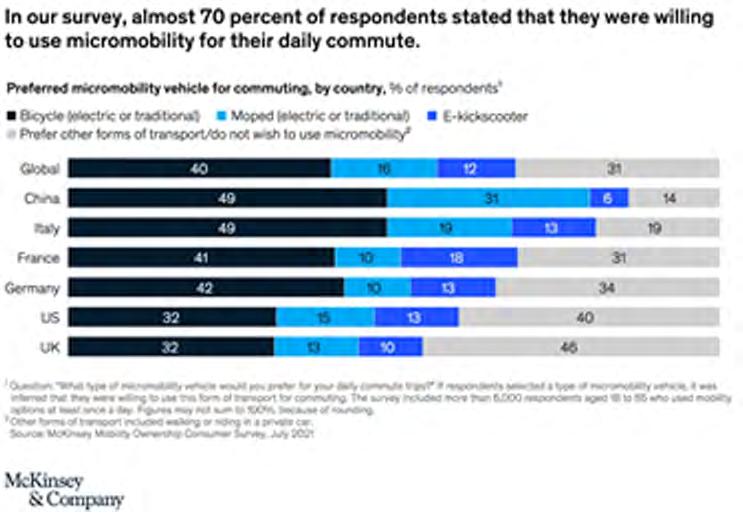
11 minute read
ezBike: Revolutionizing Mobility or Just another startup?
ezBike:
Revolutionizing Mobility or Just another startup?
Advertisement
The company aims to develop the EV ecosystem in the country but is it that EZ?
By Ahtasam Ahmad & Taimoor Hassan
The lack of quality mobility infrastructure in Pakistan is an inescapable fact. The government and the private sector have come up with solutions to this problem in the shape of initiatives like Metro Bus service and private ride hailing companies like Careem, Uber and Bykea. However, these solutions are insufficient to improve the deplorable state of the country’s transportation network. As per the World Bank, “Insufficient transport infrastructure results in congestion, delay delivery time, fuel waste, pollution and accidents which build inefficiencies in the economy and costs the economy 4 to 6 percent of GDP each year.”
An Islamabad based mobility startup ezBike plans to alleviate Pakistan’s mobility vows by providing electric scooters as an alternative transport solution. The company plans to commence production and sales of electric scooters following a million dollar raise in a pre-seed round. ezBike was launched in October 2020 as Pakistan’s first electric scooter sharing service by Mohammad Hadi, a former investment banker, and Ali Moeen, a software executive. Since its inception, the startup claims it has boarded over 100,000 customers who can book an ezBike parked around the city of Islamabad.
The recently raised capital would be used to build a comprehensive ecosystem of its own for electric two-wheelers, including an electric scooter assembly facility, and low-cost lithium-ion battery production which will lower the cost of electric scooters for customers.
The business idea might seem attractive but are the fundamentals present for this startup to grow in a sustainable way?
The concept
The first service that the company launched was a last mile solution in form of shared electric scooters that were scattered across a few sectors in Islamabad and the USP for this service was being driverless which meant that customers would drive the scooters themselves and as the company operates a dockless model, they can park anywhere and leave. While talking to Profit, Ali Moeen, explained, “We chose to operate under a dockless model because it enables better mobility for the customer. If we see that a bike is somewhere that is not safe or chances of it getting booked from there are low our repositioning team goes there and relocates the bike to a safe and high demand area.”
However, the current model does raise some eyebrows regarding customer safety, theft prevention and licensing for operating these vehicles on the road. Regarding the customer safety and licensing requirement, Muhammad Hadi, explained to Profit, “According the Bye laws of Motor vehicle Ordinance 1965, license is needed to operate a vehicle that can travel at speeds in excess of 40 kph or has a 50cc engine. In our case the top speed of the existing fleet is 35 kph and electric scooters don’t have cc engines.”
“The bikes have been tested and mod-
ified for a safe driving experience, however, we are arranging insurance for our customers to cover any losses in case of an accident.” Hadi further added. Responding to Profit’s query regarding theft and loss prevention, Ali Moeen, stated, “We have multiple security layers in place to prevent such incidents. Additionally we do have our fleet insured.”
However, the startup is not looking at the ride sharing business as its primary source of revenue rather it aims to expand into the Business to Business sales (B2B) of electric scooters starting with the delivery service businesses including the likes of Airlift and Foodpanda.
The model
The mobility sector startups face a lot of criticism for their unsustainable unit economics. Most of them make a loss on each ride and endup burning a substantial amount of investor money with very little to show for it. However, in the case of ezBike, as expected, the unit economics are on the positive side. The reason for that is low overheads and fuel cost savings. In order to better understand how this works let’s take a look at an example of an average ride on these bikes. If one of these bikes is used for a trip from the F-8 sector in Islamabad to the F-10/11 sector it would take around 14 mins to complete the ride given the limited speed of the vehicles . This would cost the users around Rs 90 as the per minute charge for a ride is Rs. 6 and activation charge is Rs 5. For the said ride, the company will incur a cost of around Rs. 8-9 in form of depletion of battery charging while the fixed overheads include insurance at around 3%-5% for the cost of the vehicle as well as tracker charges, internet charges and salaries of comprising mainly of unskilled workers deployed for bike repositioning and battery swapping (will explain this later). Ali Moeen, while explaining the business model stated, “ We recently reduced 30% cost of repositioning staff which is our main overhead by incorporating tech. As for the charging cost, right now it is less than a rupee per kilometer. Other overheads like insurance are negligible for us.” The planned pivot to the B2B sector would commence with ezBike establishing its own assembly for which the founders are hopeful to get a license by the end of June. In the current bike sharing model, ezBike is already importing bikes in completely knocked down (CKD) unit form and assembles it locally. This saves a substantial amount as CKD incurs around 20% taxes and duties compared to 117% for importing Completely Built Units. The startup plans to indigenize the assembly and manufacturing process as much as they can for which they have certain JVs in process that they refrained from discussing about. However, the market they are targeting is delivery fleets that include foodpanda and Airlift riders. Co-founder Muhammad Hadi told profit that the vehicles sold to the B2B market would have functionality comparable to the existing CD 70s used by the riders. He also mentioned that the cost of the new Bikes would be around 70%-80% of popular CD-70 models.
This would suggest that the Bike would cost around 75,000 and given that the battery prices are approximately 40%-50% of the total cost, the complete product might cost around Rs150,000. The value proposition for the delivery fleets is that they would be able to save around 50% of their fuel cost. Further, ezBike is also working on a financing arrangement with a leading bank to enable the riders to buy the vehicle on installments.“Once the rider pays the down payment, his fuel savings would be enough to cover the installments which will enable him to own the bike in 12 months”, stated Ali.
The battery cost on the other hand is not included because the company plans to set up swapping stations, as mentioned earlier. Basically, battery swapping is a way to get around the problem of charging bikes. As in their Bike sharing model, there would be surplus batteries compared to scooters on the road that will enable a leasing mechanism for B2B market. This, as per the founders, would be done through establishing battery swapping stations across the cities where ezBikes are provided to the riders. The startup aims to set up a facility with capacity of producing around 20,000 bikes annually. While they also intend on launching a swapping system with initially setting up between 10-15 stations. Regarding the cost of building a swapping station, Muhamamd Hadi stated, “It depends on the size / number of batteries and speed of chargers. We are exploring partnerships with engineering companies on the installation and maintenance of the stations.”
However, this makes it a very capital intensive business model, but as per Ali Moeen, “Going forward our Bike fleet will be financed (Bank Lease) so we technically take the bike assets off our balance sheet and this will help us to maintain a healthy liquidity”

Muhammad Hadid, co-founder ezBike
Analysis
The startup ecosystem in the country suffers from the plague of unsustainable business models. When the basics are not right, expanding further would only result in a higher burn rate. Further, the bearish trends in the startup funding market will result in many startups finding themselves short of funds very soon and would need a change of strategy at the very fundamental level.
Profit reached out to a source that was familiar with the financials of ezBike who vetted claims of the founders regarding the unit economics and bike costs. He further explained that for the existing ride sharing model, even if the depreciation (cost of using assets) is included the company would still be on the positive side in terms of unit economics.
Therefore, it means that the company’s business model is a robust one and has sustainability. The main reason for this is low overheads as there are no drivers and docking costs, while majority staff is unskilled and marketing and promotional cost is also negligible. In comparison, ride hailing services like careem burn a substantial amount in promotions and driver bonuses.
While analyzing the company’s financial data, we realized that another factor which works for ezBike is that through a bifurcated supply chain and a local assembly they are able to build the final product at a very competitive cost.
Further, using debt financing to facilitate the buyers would allow them to penetrate a low income market. While using financing options for their stock (fleet) will help their cash cycle and also reduce risk.
However, the bifurcated supply channels also means that ezBike’s success is heavily dependent on its strategic partnerships both at the backend of the chain as well as the frontend. This might cause problems if any of those partners backout.
The strategic partnerships would also include the delivery services. Foodpanda has around 50,000 riders while Airlifts fleet is around 40,000. Other services are also potential partners but the number of their riders is well below the aforementioned figures. ezBike aims for an assembly of 20,000 units annually which seems to be on a higher side given that the numbers for last mile delivery bikes are limited and the market won’t operate under a complete EV model in the near future. Further, the delivery services are churning out huge losses and one example is Airift which has significantly reduced its operations recently. This might leave ezBike with an idle capacity that would be detrimental as overheads would increase.
As far as the product is concerned, lithium-ion cells can rapidly release the energy they contain by venting smoke and flames in a manner that can ignite nearby materials as well as other lithium-ion cells. Negative public perceptions regarding the suitability of lithium-ion cells or any future incident involving lithium-ion cells, such as a vehicle or other fire, could seriously harm their reputation. Ola, an Indian e-scooter manufacturer came under fire when its scooters literally caught fire. As per News-18 an Indian publication, “Recently, there have been multiple incidents of electric vehicles (EVs) catching fire and resulting in deaths and severe injuries to people.”
Additionally, debt financing the vehicles would be challenging as Banks will be reluctant to lend to delivery riders without guarantees due to high credit risk involved as these riders hail from a low income background. While convincing the riders would also be an uphill task. Reasons include; getting the message across and explaining the cost savings, convincing them to pay installments and the fact that riders don’t use bikes just for deliveries but also their personal use and utilities of ezBike’s vehicle can be questioned in that case.
The competitive advantage for the company seems to be its learnings from being in operation for more than a year and a half. However, there is a reason why Evs haven’t gained the traction in Pakistan that one would expect given the rising cost of fuel. The reason is a non-existent charging and maintenance ecosystem. The founders of ezBike are aware of this fact and aim to develop an ecosystem and replicate the success of the likes of GoGoro, a Taiwanese electric scooter, that earns around 30% of its revenue from just its battery swapping and maintenance services.
As far as the scooter sharing business is concerned the company is not looking to rapidly expand in that segment. However, they might be better off partnering with the public sector to expand the last mile solution in the future. The founder did indicate that they were evaluating an opportunity with a certain city administration which might lead to their first partnership in the public sector.
If the overall model of ezBike and their plan is evaluated from an investor’s point of view, it seems comparatively less riskier than some recent startups in the mobility space. This is primarily due to a low sunk cost model. However, if the company is to grow and maintain its first mover advantage, a rapid vertical expansion is necessary and as per Profit’s estimate for that they would need to raise a further capital of anywhere between $5m-$15m.
Ali Moeen, co-found ezBike
Supporting Graphics









